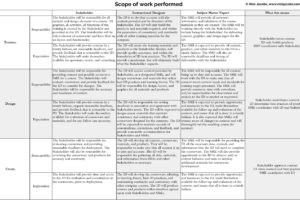One of the things I love about what I call “thought industries” is the plethora of opinions, ideas, and theories that exist. It is always fascinating to hear people say “this is how it is done” or “this is what the experts say.” For every experience, opinion, or process I will talk about, there is someone that will swear that I am wrong or it is this other way. The thing is – I don’t really care if people agree with me or not, but I love to read alternate views.
For instance, this post is going to be about the visceral disagreement about the “anyone-ness” in the instructional design world of thought. There is the “anyone can train from these materials” debate, the “anyone can develop any training” debate, and the “anyone can learn from this training” debate. The simple answer to these debates is yes and no.
I, myself, am a pro-anyone-ness advocate. However, that doesn’t mean it is all binary. With developing training, there will always be assumptions and caveats. The claim “Yes, my training can teach anyone how to run” is followed by the caveats “if they are physically able to run, if they have the correct tools to engage in running, if they have already learned to walk, etc.” The assumptions are that “these people want to run,” “these people have capacity to understand the concept of running,” “these people speak the same language well enough to understand training direction,” etc.
Notice, I didn’t caveat or assume materials, teaching modality, nor the background of the instructor. That is what makes me a pro-anyone-ness advocate. I believe that any training, developed as well as possible, can train anyone, by anyone. But…
There is still a caveat to being a pro-anyone-ness advocate – in neither the caveat of the training, the assumptions of the environment or participants, nor in the position of being pro-anyone-ness did I discuss the quality of the outcomes. This is where the hangup is and where people want to force it into a binary “all or none” existence. These binaries are almost entirely impossible to enforce and why contingencies and mitigation is necessary.
I believe that anyone can teach any course. That impacts how I develop my materials, so I also believe that the training must have as much real knowledge as possible to eliminate as much dependence on tribal knowledge as possible. With the right materials, anyone should be able to deliver any training. The outcome caveat to that is:
“my training materials are sufficient so that anyone reading just the participant guide can achieve a C result. Anyone without a background in the material can train people to at least a B result. Anyone with a background in the material can train to an A result.”
I call this the “bad pork burrito” standard. If all of the trainers are suddenly unable to come to work because of a team dinner of pork burritos waylaid them, training must continue, so the replacements cannot be expected to have the tribal knowledge a trainer has – all knowledge must be in the materials. If all of your knowledge of how a business operates is with your trainers, your business is one trainer failure away from collapse.
So, being a pro-anyone-ness advocate, I insist on making sure that I have multiple sources of information. I always ask for two to three Subject Matter Experts to be available, and I gather as much tasking information as possible, so that anyone can train the material. Anything less is my failure, not a trainer’s.
Then the “anyone can develop training for any industry” part of pro-anyone-ness has caveats as well. The caveat for this is access and analysis capacity. In many instances, I believe that it is actually better to have someone without experience in an industry to develop training because they come in without bias, preconceived notions, or assumptions. The key, though, is that person better be one hell of an analyst, have a lot of curiosity, and willing to ruffle feathers with a lot of “why?” questions.
I have a lot of background in developing training for public safety and technology. The one thing they have in common is doing things as they were shown to do them without ever asking why. They also believe that someone must have expertise in those fields in order to develop quality training. The problem is, there is a lot of detritus in those fields that exist only because they have always been done “that way.” No one has challenged the “why” of something in a particular training, and so the detritus persists. Both industries are rule-following, require things to be done in specific orders or processes, but they are also based on a lot of generalizations applied specifically, so the training skews.
With an excellent analyst, some of that detritus can be scraped away. Sometimes asking “why” might reveal a systemic issue that can be eliminated. Sometimes new efficiencies are found because the current era isn’t dependent on the same assumptions that the previous eras were.
Being a pro-anyone-ness advocate informs my own processes for how I set expectations with my stakeholders, what my goal of analysis will be, and reminds me to be wary of my assumptions and preconceived notions. This makes my training more effective in quality and in outcome. It also helps me be more strategic in developing the training and gathering the information I need. If my goal is for anyone to teach anyone, I better have as close to everything I can get in that training. It also helps me negotiate and educate the stakeholders, while also making my analysis and discovery more directed – I know what questions to ask in preparing for the planning, making me more efficient.





